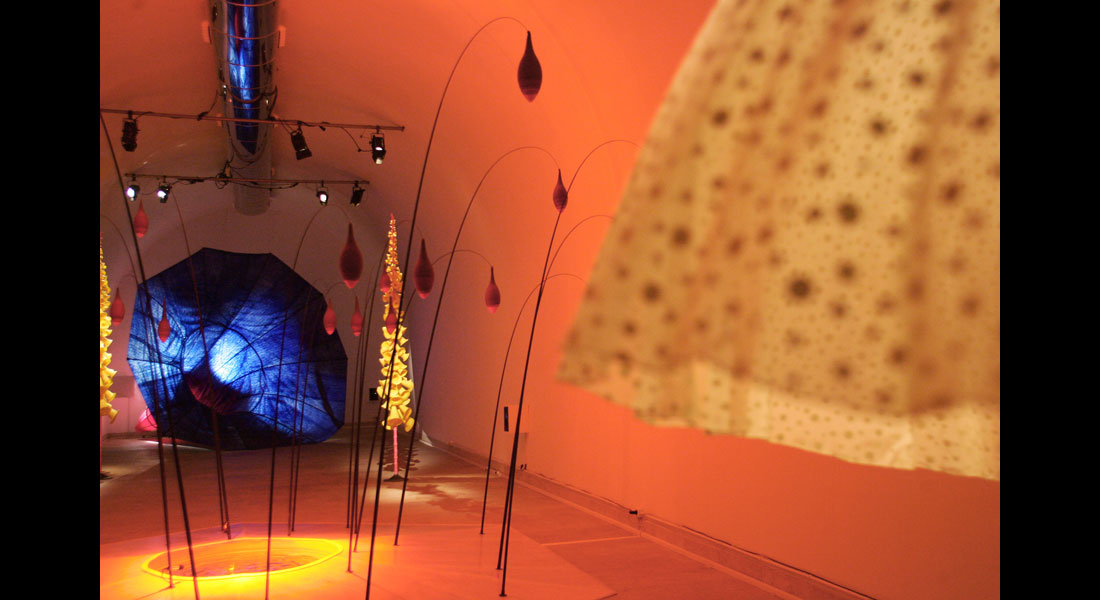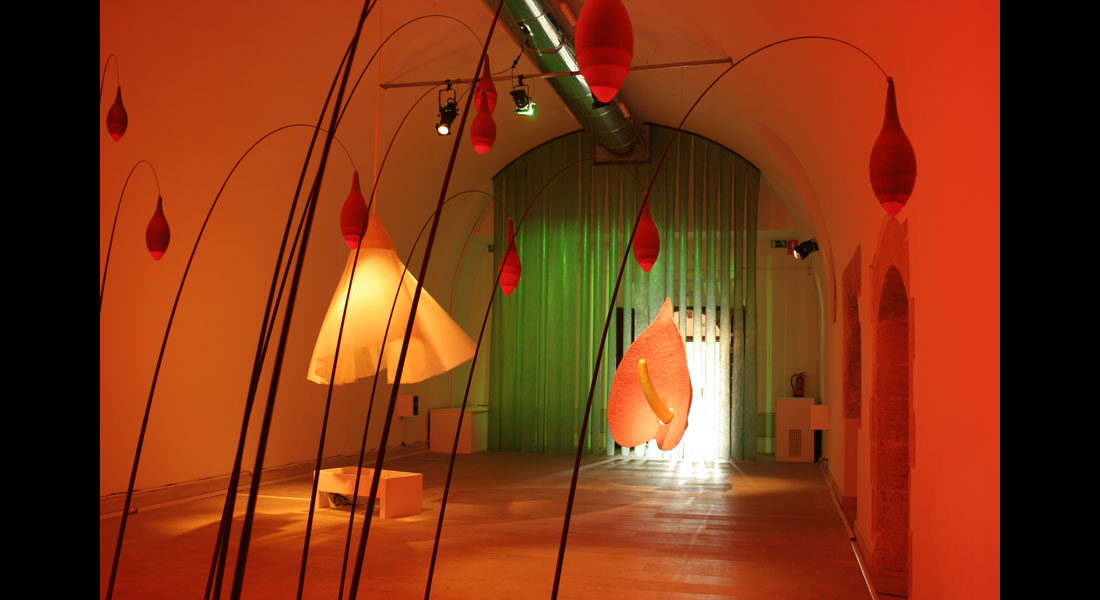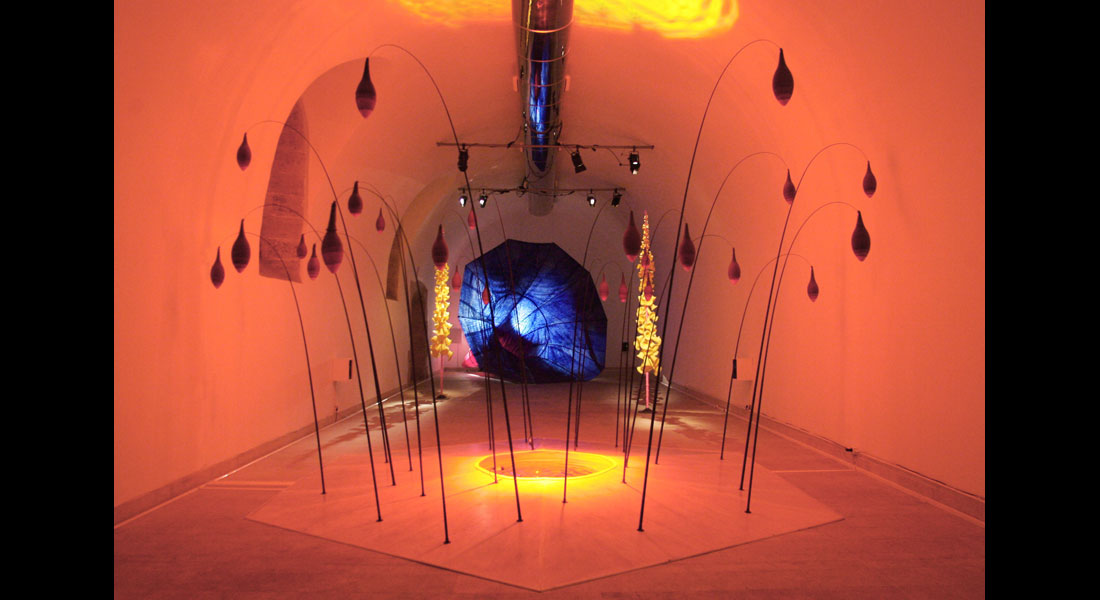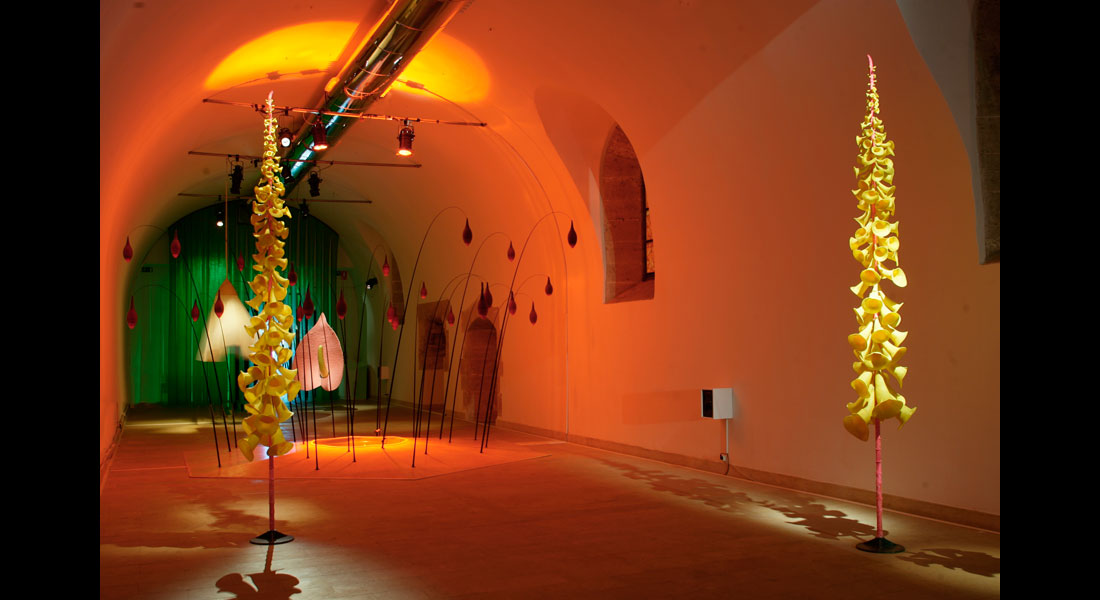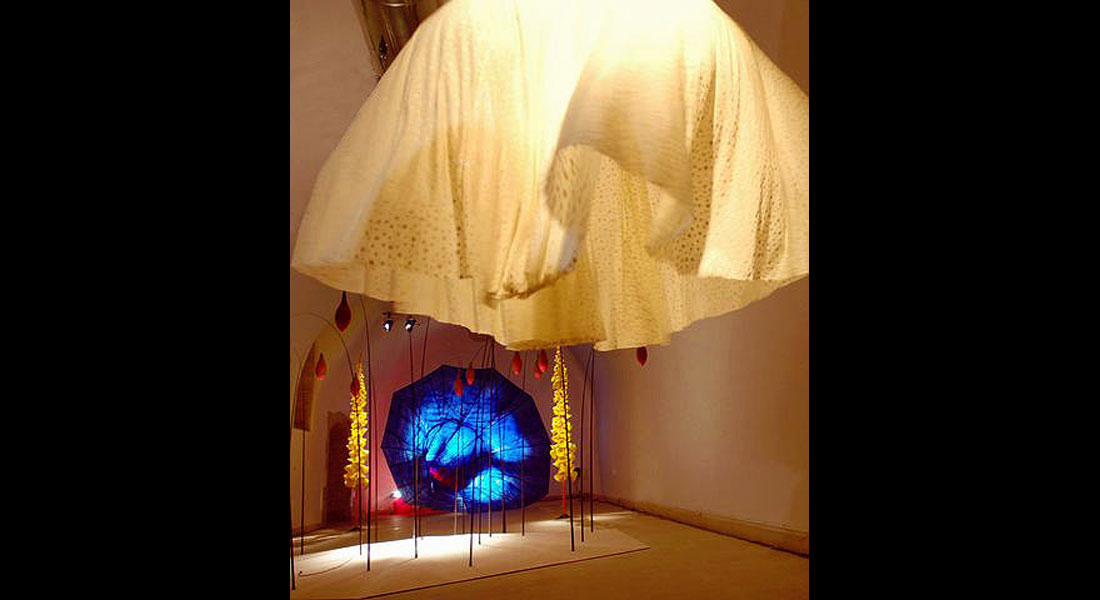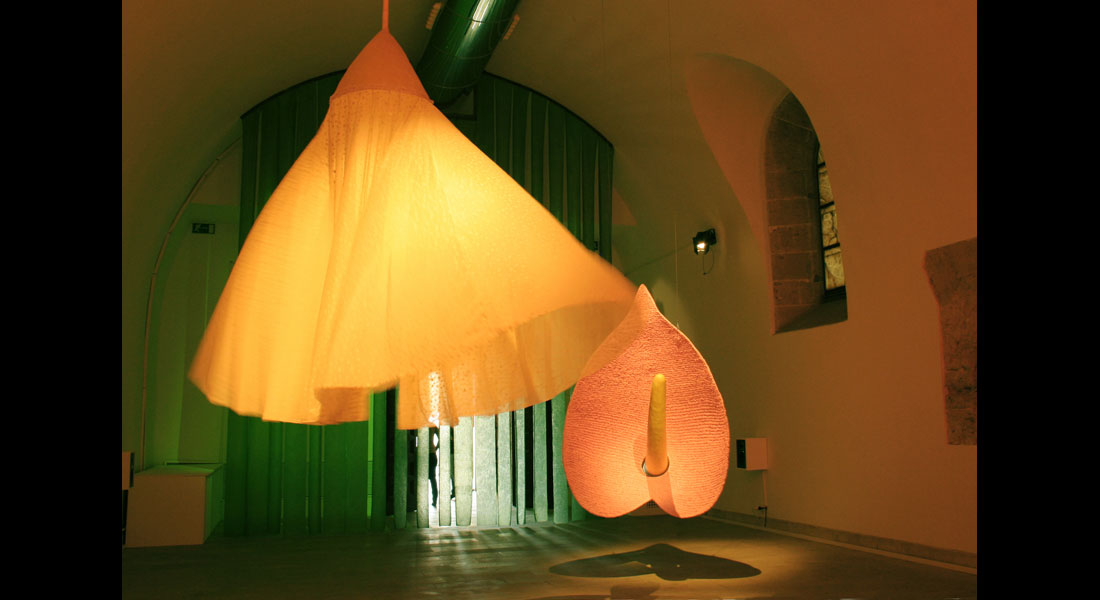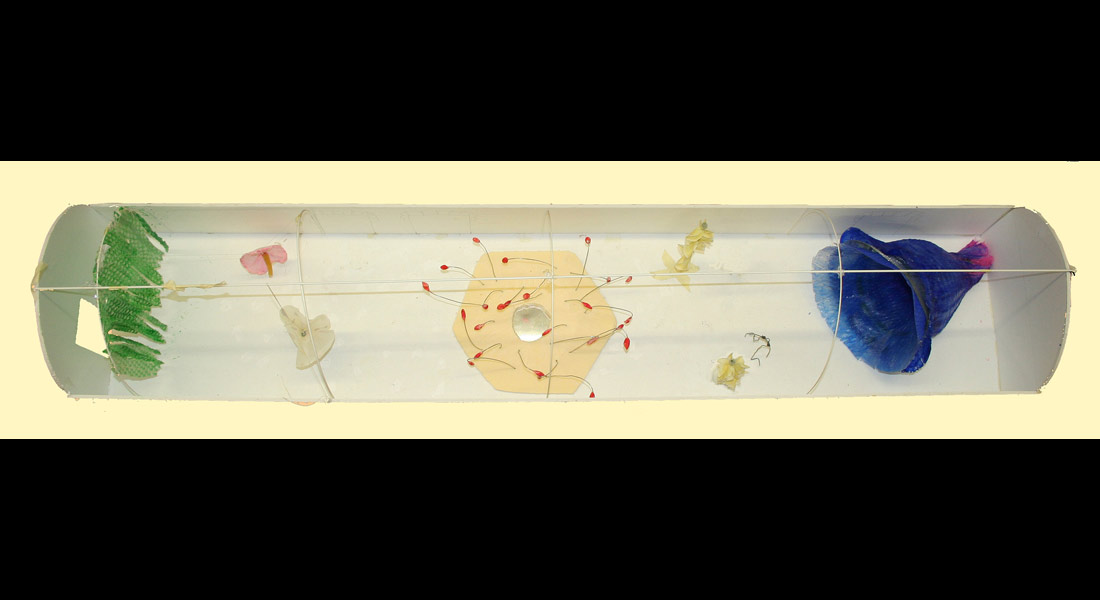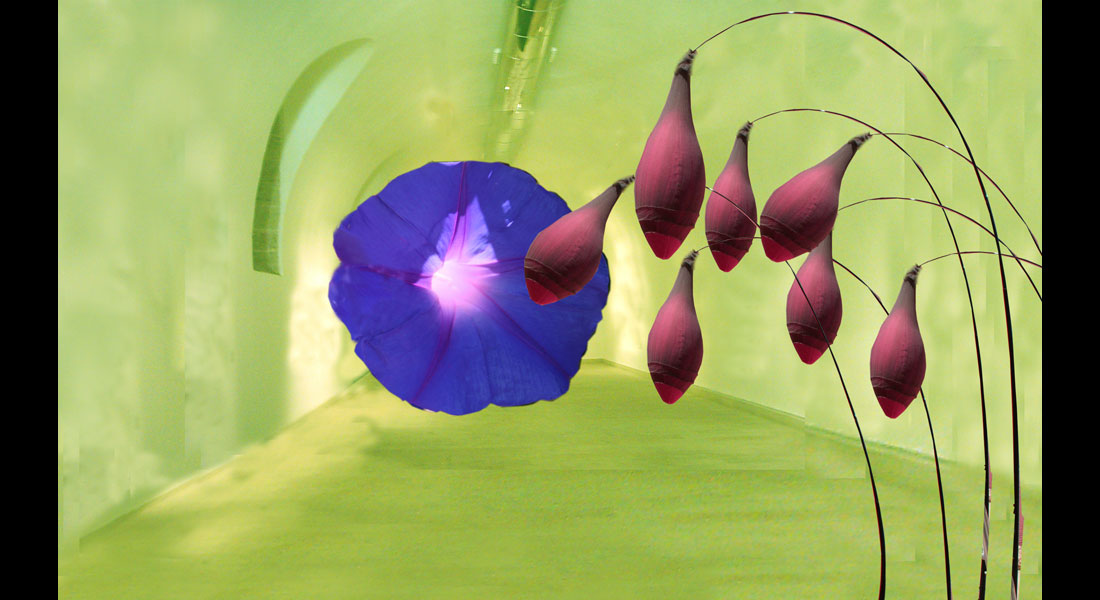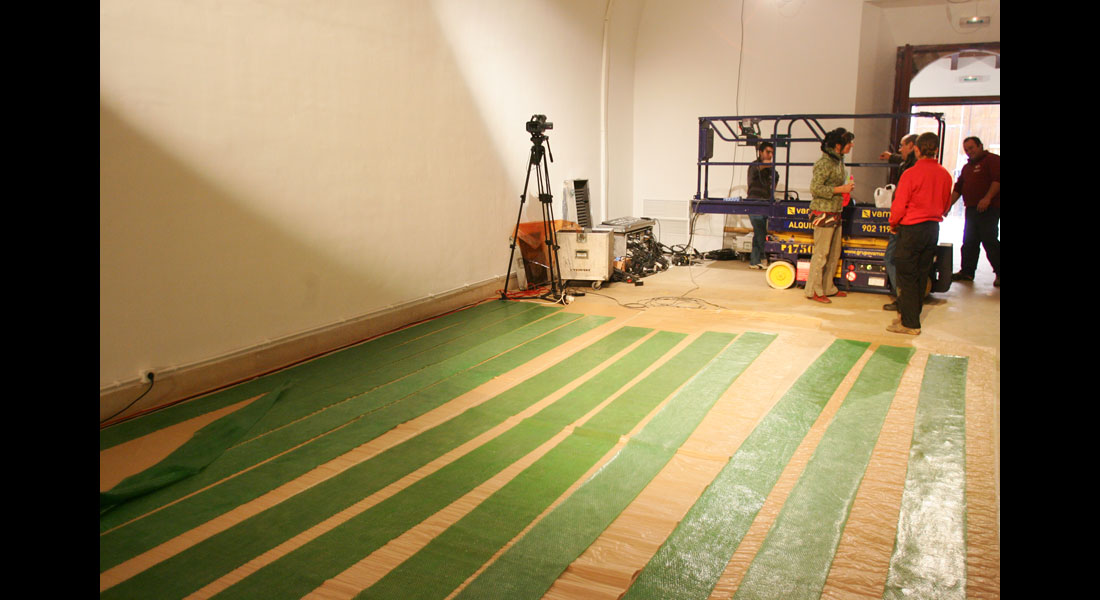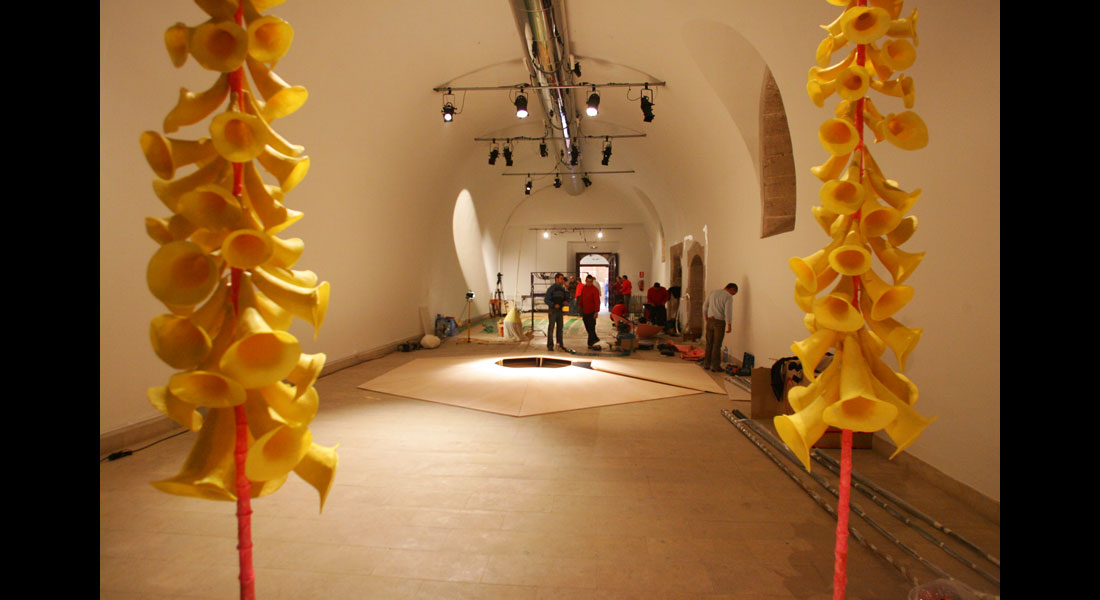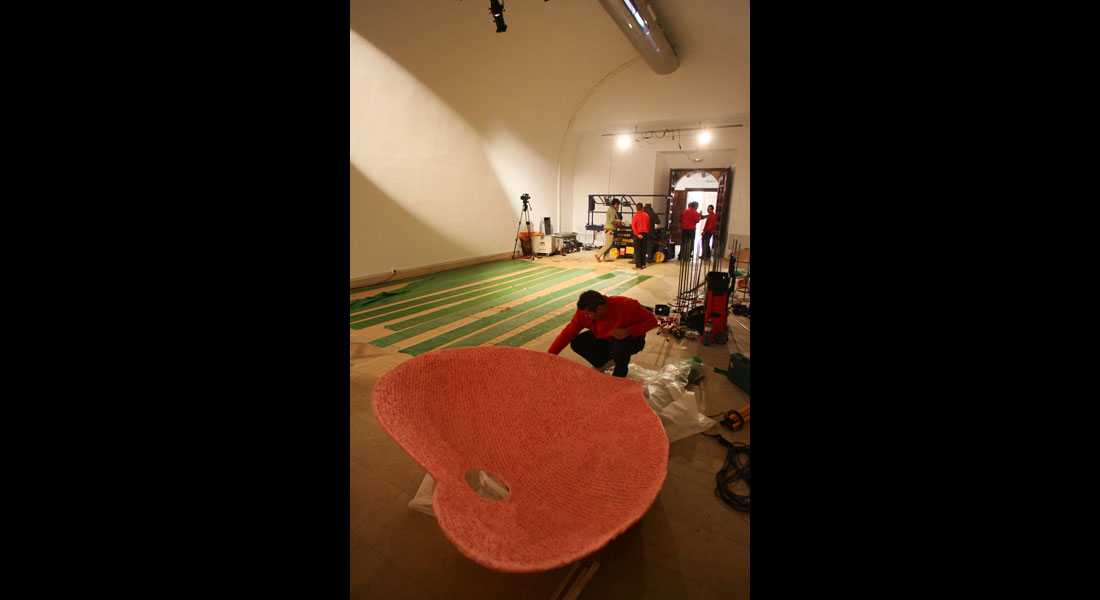Project Description
Plaisir de Fleurir 2007. With music of Leopoldo Amigo. Sala Parpalló. Valencia.
WATCH VIDEO:
THE TEACHINGS OF NATURA
José Albelda
In the artistic sphere, the art-nature pairing is usually specified through what is called poetics of respect and integration. For instance, in a context where nature is a landscaped garden, a wild area or the countryside, the artist takes part through his work which, depending on the materials, the size or the type of relationship with the environment, he/she expresses the metaphorical intention indicated.
However, this is only an option among a great variety of possibilities to draw ourselves closer, through art, to everything that the biosphere offers us. The same is true for words that deal with the relationship between art and nature. It is not obvious that an analytical approach or an essay may be the best option to express the feelings that Monique’s work arouses in us. Therefore, after this brief reflection, maybe it would be appropriate to change the language registers to reconcile them with the works and continue with them on the path that will lead us to the original matrix.
Reverence for lichen or moss does not mean paying homage to it -making a slight gesture leaning your head -, but lowering ourselves to their level, getting close enough and with sufficiently sharp eyes to discover their tiny blooms. Because moss also flowers; it is not an immobile tapestry of green velvet. This exercise of measurement-of physical height and depth of perception- symbolizes the difference between superiority and respect. Knowing how to situate ourselves in the context of the cosmos, the place that we occupy among the moss and the stars. Then we will understand that our greatness is not so big. We state it from a haiku of the master Matsuo Bashó:
I’m only a man
eating his soup
before the Morning Glory Flower1
Man and flower at the same level, that’s all.
But this is not usually the most common perception. This is why it is urgent to correct a collective short-sightedness that is blinding us and that prevents us from appreciating the omnipresent party of life, with all its frantic activity, its harmony and its whirl. Teaching people to watch has always been one of Art’s tasks. Then, the fascination begins: was all that biodiversity necessary to achieve the purpose of life? We will never be able to know why Natura Naturans illuminated such beauty and decided to show itself through millions of different, interconnected and irreplaceable fragments. They spread themselves before us at the expense of our care or devastation.
Natura’s first lesson: everything has its place and its purpose, nothing lacks function, nothing is dispensable. The jellyfish and the tortoise, the prey and the predator, the germ and the blue whale. We are all participants of the bittersweet challenge of existence; we also, who can write about the germ or the whale, who can recreate the jellyfish, the pistil, the anemone. We are fascinated by the thousands of faces nature manifests: Natura Naturata. But we will only appreciate them if we dare to leave the artificial placenta that we have built around ourselves. Then we will feel the uneasiness of its polarity: we will gaze at the exact moment when the dew becomes a drop and slides down a petal; but we will encounter hundreds of plant fleas absorbing the sap of the tender stems. Beauty and frightfulness coexisting in tininess.
Natura’s second lesson: everything alive is in motion; nothing remains static in the birthplace of time. Everything that is born transforms, grows, reaches its fullness and slides itself towards its decadence until death receives it. That death, which is life’s right conclusion, is not a failure, is not a loss. But while life exists everything tends to cross, to pollinate, to fertilize, to produce fruit. The magic of desire and pleasure allows the biosphere to continue beating. Life that wants to perpetuate itself through its makers. We could call it the beginning of pollen: while there are bees, while they want to suck to be able to live and while stamens exist for receiving pollen that is transported on their legs, then, a great part of plant life will continue existing. Thus, we will continue being here as well, much to our regret, without any gratitude for the bees. Blind, impenitent, forgetting that we are bound to the seed, the oak, the amphibians and the first seaweed. Eduardo Galeano reminds us of this with one of his wise stories:
[…] Before the before, in the times of the world’s childhood, when there were neither colors nor sounds, they, the blue seaweeds, already existed. Releasing oxygen, they gave color to the sea and the sky. And one fine day, a day that lasted millions of years, a lot of blue seaweeds decided to turn into green seaweed. And the green seaweeds went on generating, little by little, lichens, fungi, mosses, jellyfish and all the colors and the sounds that came next, trivial, to excite sea and earth.
But the other blue seaweeds preferred to remain just as they were.
That’s the way they still are.
From the far-off world that was, they look at the world that is.
It is not known what they think.2
But some of them decided to become green, and that is what counts. Although we still don’t understand that we are their descendants.
Before continuing with Art’s necessary commitment to life, here is a last example of our lack of respect. It is hard for us to understand the link between paper and trees, between frozen Christmas prawn and the destruction of mangrove swamps. That is why only some people feel their heart breaking when they hear the murmur of the power saw, which destroys the life that primary forests shelter without even having had the opportunity of greeting it. Only a few of us intone a requiem for each species that becomes extinct. It will never offer us the helicoidal treasure of its DNA, or the incomparable beauty of its shapes and habits. But, who do we think we are? Let us remember Voltaire:
Nature (to the philosopher): Since I am all that is, how can a being such as you, such a small part of myself, seize me? Be content, my children, being atoms as you are, with seeing a few atoms that surround you, with drinking a few drops of my milk, with vegetating for a few moments on my breast, and with dying without having known your mother and your wet nurse.3
Natura’s third lesson: everybody is part of a whole. We think we are different, but we are not so different; plants, animals, humans. We all have in common our blood/sap, we all depend on water to live and the same oxygen gives us life. We all share the same cycles: we are born, we grow and we die. We have sex and we reproduce ourselves; maybe we also share the pleasure of finding a companion. We are, therefore, participants of the mystical unity. But once again we are not aware of all that. We just respect those things that are close to us, what we consider as being at our same level and scale. Herein is another of the artist’s tasks: to draw closer, to place within our reach everything that is important but we did not know how to listen, to smell, to feel; To arouse in ourselves the essential sensitivity that we have lost because we submerged ourselves in our cold digital world. From here we resort to the principle of responsibility: now I know what I destroy and how I destroy it, and I know that I am morally responsible for ignoring it. Now I know everything that I could not perceive and that had always been right in front of us. If I want to, I will renounce what is offered to me, but it was already shown to me, I already felt it.
One of the main commitments of the present-day is to pay attention to Natura’s teachings. We, the artists, as artisans that work material, can spread the principle of hope to restore little by little the balance that has been lost. Through Art, we can explain the magnificence of small things, the exact size of the human being in the world’s lap, life’s amazing persistence. We have the responsibility of representing Natura, of symbolizing it. We offer you the ceremony of the bond, of the game and of the joyfulness and, in return, we only ask you to make yours the principle of responsibility towards every being that lives and flowers.On Temptations and Dangers, and the Insignificance of Man
**********************************************************************
ON TEMPTATIONS AND DANGERS, AND THE INSIGNIFICANCE OF MAN
A month before the opening of Plaisir de Fleurir in the Sala Parpalló, Monique Bastiaans was in Nagano for an exhibition. She came into contact with Shinto, the native religion of Japan, which is characterised by reverence for nature in all its forms. It was a spiritual homecoming in a world that could easily have been hers. From her earliest days as an artist, love and respect for nature has been one of the central themes of her work. She experienced Japan as a confirmation of her approach and she gained new inspiration.
Twenty years ago, Monique Bastiaans – who was born in Mons in Belgium in 1954 and was raised in the Netherlands – found herself by accident in Chiva, a village near Valencia, where she has remained ever since. In that period, she has made her mark on Valencia, while showing the restraint that is so typical of her. Without knowing her name, there is no inhabitant of the city that does not know her work. Earlier this year, she filled the local Colon underground station with objects that recalled organisms living in the depths of the oceans. Aided by the effect of glass partitions, she gave passengers the feeling that they were in a tropical aquarium. The imaginative world of Monique Bastiaans counterbalanced the realism of the local L’Oceanografic tourist attraction that she never visited.
The first time that Valencia got to know her work was when she created Red + Azul in 1994. Against the background of a blue-painted factory building, she laid out a
fan-shaped construction of waste wood linked by rubber in front of the fabrica de Cross, which was under threat of demolition. Many inhabitants will remember the net of transparent rubber rings that she hung above the Plaza de la Lonjeta in 2001. In the same year, she created another, more subtle, work called Dulce cielo, Séptimo hogar. By using nylon fishnets stretched above the Calle de la Reina, she was able to catch the silver sunlight in continually changing shapes and hues depending on the wind. Since the coming of Monique Bastiaans, the inhabitants of Valencia have been looking at their city in another light.
Although she exhibits abroad on a very regular basis, the art projects in her beloved Castilian landscape are those that create the greatest sensation. These include Medusea, the thirteen giant silk-enclosed polyester jellyfish that she created in the surf on the Playa de las Arenas in 1996, as mythological messengers from the depths of the ocean. There was also the monumental Adéu Tristesa dating from 2000, when she wrapped 270 dead orange trees in red sheets as homage to millions of aids sufferers. Time and again, Monique Bastiaans reminds us of the comforting power of nature, a never ceasing source of life and inspiration. Even dead nature, such as the orange trees that succumbed to an infectious disease, is full of undeniable beauty and vitality.
It seems as if she is trying to tell us that, if a God exists, he communicates not by books, but rather by means of his creation: nature. This is an understandable attitude from someone who was raised in the country of Spinoza, the seventeenth century rationalist philosopher who equated God with nature: Deus sive Natura. The ancient Japanese Shinto, which Bastiaans recently came into contact with, is, like all animistic religions, based on the same idea.
Monique Bastiaans’ art has no place for treatises and manifestos, or for religious viewpoints. Nevertheless, Plaisir de Fleurir is an unmistakable reflection of the place for which it was created: a former cloister of the El Real Monasterio de la Trinidad, the oldest convent of Valencia (1445). In the 35-metre long and 7-metre wide
tunnel-shaped cloister, she has created a spiritual path in which all senses, with the exception of taste, can be experienced.
The path winds it way through a 21st century mythical garden, which is revealed after passing a curtain reminiscent of classical temples. A mythical garden should – and the nuns in the adjacent convent will confirm that – include the first people in the story of the creation. In Bastiaans’ version, Adam has assumed the form of a large pink arum with a moving yellow pistil. Eva is perceived as a lifted spotted dress lit from below, a reference to the famous Marilyn Monroe scene in the Seven Year Itch. This is imagery, just as poetic as it is explicit, in which the heavenly temptations and the associated risks go hand in hand.
Plaisir de Fleurir is not only a contemporary variation on the classical mythical garden, it is also a dialogue with the adjacent Monasterio de la Trinidad. As a result of their vows, the sisters are obliged to avoid contact with the outside world. The convent garden is therefore terra incognita for the public. And yet, Bastiaans does extend her hand from the other side of the wall. She has revealed the doors of the Sala Parpalló, which were masked behind a wall of heavy cardboard during previous exhibitions. It is as if she is trying to say: show that the doors are there and use them! At the same time, the transparent figures in the garden gaze longingly at the windows of alabaster, that wonderful veined natural stone that lets in light and which links the cloister to the forbidden garden behind it.
The parallel with the forbidden garden of the Monasterio is also visible at the heart of Plaisir de Fleurir: the well. In the case of Bastiaans’ work too, the well offers a view of your soul, but not without obstacles. On approaching, the surrounding structures move and so do the trees containing large, dark red fruits (forbidden fruits or fruits of immortality?). But before you know it, the reflection in the well has gone! And that’s what happens if you try to examine your soul, things are revealed but you don’t learn a great deal in the process. Further on, two trees with yellow trumpet-shaped flowers point the way, like heralds, to the end of the garden, where a large blue and pink funnel-shaped flower gazes enticingly. The garden exit is the beginning of a tunnel, the end of which is invisible.
Plaisir de Fleurir has given Valencia – the town with the alabaster windows and the hidden gardens – a contemporary sculpture garden that combines myths both young and old. Monique Bastiaans is a sculptress par excellence, but as is her custom, she rejects traditional materials such as natural stone and clay. She shows that structures made of nylon, latex and paraffin wax also have a soul, provided that they have something to say, and that something must be a product of your own imagination.
Just like the polyester-enclosed jellyfish of Medusea and the lovingly wrapped dead orange trees of Adéu Tristesa, Plaisir de Fleurir reveals, in a light-hearted and organic manner, the beauty and cruelty, the temptations and the dangers of our world, and the insignificance of man in that respect.
And as we have come to expect of Monique Bastiaans, she works with a great deal of respect and devotion. Which will probably please the sisters of the Monasterio de la Trinidad too.
Wido Smeets
***********************************************************
PLAISIR DE FLEURIR BY MONIQUE BASTIAANS. CONTEMPORARY DEMYSTIFICATIONS REGARDING THE “LOCUS AMONEUS”
By Rosa Ulpiano
For Platonic philosophy, in the idea of nature based on the theory of design everything corresponded to the arrangement and purpose of nature observed by the artist- it was a second order reproduction of knowledge, moving away from premises such as what is existent and what is invisible1. This metaphysical burden would evolve through time toward a physical framework, a cultural structure, treated by different artists with an aesthetic approach, in which nature was a stage complement, where human beings appeared; it was a secondary value seen from an anthropocentric view, an order subjugated to the artist’s gaze. Nevertheless, it was in the 19thcentury when that classical metaphysical burden resulted in a superior entity, in an environment where, from then on, the human being started to occupy a position in the cosmos and whose intervention therein would rebuild longingly a memory of landscapes that existed.
Those are landscapes that have been impoverished, mostly by human intervention, and which through an aesthetic projection are transformed today by the particular vision of their creator. Sometimes by means of painting or sculpture, some other times by using new mass media or by its legitimization through Land Art, or landscape intervention, transforming them into captivating spaces. However, it should not be about an attempt of saving or improving them by returning to their origin, but rather an aesthetic masking of those assaulted landscapes -both urban and rural- in order to provide them with a new aspect through painterly and conceptual artifice. In this sense, during her whole artistic unfolding, Monique Bastiaans has made interventions in a variety of spaces. Thus, in 2002 she installed large red cloths on 270 dead orange trees in Ribarroja del Turia in her piece “Adeu tristeza”; in 2006 she presents at the Dutch Odapark of Venray “Por si las moscas”, where the artist rebuilt some artificial winding paths through the forest. Monique creates installations that play with the senses of sight, touch, hearing and smell in order to elicit different emotions from the spectator. Gradually her sculptures – made of different tissues, plastics and silicones – show that the artist is constantly looking for new technical, aesthetic and formal solutions through an abstract language which also reveals her taste for organic shapes and for nature. In her work Plaisir de Fleurir, Bastiaans recreates a sophisticated play of lights, smells and sounds, rich in nuances, which stresses the abstract effect of the composition; an intimate space where Bastiaans melts shapes and concepts through a stimulating vocabulary aiming to rekindle our look across these magic and enigmatic spaces, recalling manifold gardens impregnated by a sense of perpetual transmutation, by an alchemical and mystical impression.
Plaisir de Fleurir, refers symbolically to the holy garden of medieval allegorical thought,… and whose preceding models catch a glimpse of certain places and identities of primitive gods, as well as landscape alterations of unconsciousness. And the truth is that along mythology, worship or religion, divinity has always been sought in temples as well as in visions and dreams regarding nature. A wonderful and intensely yearned place “Locus amenaus”; a place for meditation, a sacred place of deities adopted in medieval times, or a worldly garden, sensual, evocative of legends of the Near East, the heavenly garden of goddess Siduru2, which Gilgamesh, King of Uruk, entered in search of immortality, a paradise of trees covered by precious stones and lush vegetation. Predecessors of the Christian Heaven on Earth, the garden of Eden of the Holy Scriptures, like those precious stones and brilliant materials often represented in decorated illustrations, and the portrayal of the World Mountain, where tradition places the Garden of Paradise. It is a secret garden masterly illustrated by Hieronymus Bosch (1453-1516) in “The Garden of Delights”, by means of associations which describe the erotic aspects of life, exotic pleasures which recall the «amoris curia», the labyrinth of voluptuousness with the well or pond from which large lilies arise, or the evocations of Merrily, the ante-chamber of the “love spring”, used by the lascivious and recalling the Love Garden as well as the illustrations of the Roman de la rose. But whose intellectual and physical barriers, framed by a medieval convent, isolate it through thought or through imagination, submerging the spectator and taking him beyond a legendary hero, or beyond a courageous Gilgamesh, in other words, by a new universe, of mass media, a new culture which absorbs us, which identifies it as “natural” and which states that history comes from “nature”. This is what Marshall Mcluhan in a certain way means when he says “the new media are not bridges between man and nature. They are nature”3. Demystification of that heaven on Earth in which the dreamlike rivers, flowers and forests have lost their omnipresent importance and are now replaced by roads, cars, shopping malls, etc. The locus Amenaus or beautiful landscape, assimilated by its last representation with Gran Hermana [The Big Sister] shows this last image or last stage; the leitmotiv with which Bastiaans represents the double paradox between media and spirituality.
***************************************************************
INTERVIEW MONIQUE BASTIAANS
by Marisa Giménez Soler
Lupe Frígols Barber
This interview has been spread out over time. It came about little by little. Under a beautiful November sun, some weeks before the
exhibition, we started to ask Monique our first questions in the
garden of her studio. While we watched her at work, we helped her to dye cloths and drank a cup of Japanese tea she had just brought back from her last trip. We continued asking her questions during the
setting-up of her exhibition and also later on, once the show had opened.
To enter her studio, which is also her home, is like entering a little bit her life. Surrounded by nature, full of light, of suggestive forms and a lot of colours, it is a space that entices you. When you get there, you do not want to leave ever again.
Lupe.- You were born in Belgium, you studied and lived in Holland and I think it was sheer chance that made you stay in Valencia, in Chiva…
Yes, it was completely by sheer chance. I had come from Holland with my son to look for a place where to settle down and start over again. At first, I was headed toward the south of Spain, but at a given moment of our journey, the boy started to protest and wanted us to stop. We stopped at the closest village, which was Chiva. There, in a bar, they told me that they were renting out a house and we are here since then. That’s almost twenty years ago. At the beginning it was tough, but today I am happy.
Lupe.- Your works have always had a relationship with nature. Do you feel identified with the Land Art movement?
Yes, but I have come to this kind of art out of necessity. Nature, plants, trees, it is their energy that I appreciate most of all. If I lived in the city, I wouldn’t.
Marisa.- From you interventions in the landscape, some of them are ephemeral, some others remain…
I do not pretend to be enduring. I have a great of respect for the environment. Who am I to say: this work is forever? It stays in the memory of people as an almost ghostly image. The image you have seen remains in you, something that fits in with nature, but you actually don’t know what it is.
Marisa.- You were recently in Japan setting up an exhibition and you have returned charged with spirituality. Has this trip influenced your exhibition?
I had a clear idea about the exhibition, but it has indeed influenced me. The places that most impressed me were the Shinto temples, their architecture with a void in the centre, surrounded by nature. They can venerate, for instance, two millenary trees embracing each other. That seems incredible to me. It means to truly venerate the essence more than any sculpture of an artist, which forcibly has to illustrate this or that story.
Marisa.- In your interventions you call attention to the topics you are interested in, but you move away from the harsh and the explicit, your tone is happy, of reconciliation.
Yes, for me it is a very great satisfaction to be able to see the reaction of people, who feel euphoric, happy, when they leave the exhibition room. But I am not looking for a simple or banal euphoria. I am a little tired of so much political and social art. Everything in life is full of harsh things, on television, in the newspapers, in the news… All is aggressiveness, and yes, life is very tough. I respect very much artists who make art out of this harshness, but I believe that it is also important to stand out the other side.
Lupe.- It is obvious that flowers have an erotic connotation. Have you sought that component in this exhibition?
In “Carpe Diem” and in “Merrily” I have consciously looked for that sexual component and it is very present, but usually my work has an erotic appearance without seeking it.
Lupe.- Talk to us about colour in your work.
Colour is very important for me, it arises without thinking. In this exhibition one curiosity is that I have used all the colours. Green, yellow, red, blue, orange… I think I had never used so many before. I can choose the material more consciously because I need to create a certain atmosphere, a certain force or a certain resistance…
Lupe.- Do you use different materials depending on whether the space is open or closed?
Yes. Many of the materials I have used in this exhibition, if it were outdoors, they would get deformed, diluted with the rain and the sun. You also have to take into account other things when choosing the material. An object always changes standing next to others. That is very intriguing. Whether the ground of the room is made of wood or stone. Everything has an influence.
Lupe.- Do you make previous sketches and models?
Yes. For this exhibition I made sketches and one model. I also do it in a natural environment and even though I may not be able to delimit the space, or raise walls, I can place it in the garden in order to see how it reacts with the wind, with the sun, with the rain…
Marisa.- After having known Sala Parpalló, did your visit to the Trinity Convent and seeing how the cloistered nuns live influence you?
Sala Parpalló is a part of the convent and right from the beginning I was well aware that this exhibition would be spiritual and that it was going to be a garden, but when I entered the cloister something changed. For example, the central piece gained more importance. Although I had read that in the mythical gardens there is always a well in the centre, seeing it live impressed me.
Marisa.- You have chosen to put some curtains in order to signal the beginning of a path. You seemed decided to do that from the beginning. Why?
I wanted to divide, delimit, where the external world ends and where the sacred and playful atmosphere begins. In Dutch there is a word for separating two spaces, not with a door, but with something lighter… In the exhibition I have used four of the five senses and with the curtain I wanted to play with the sense of touch: you have to touch it in order to get in. I have chosen on purpose a material and a nice texture for making you stop.
Marisa.- Is it important for you to claim the feminine side?
I have created a very subtle garden, the most feminine garden you can imagine.At first I wanted to call the exhibition “Big Sister”. I wanted to call it like that with regard to the nuns, the big sister, the big flower, which would be the antithesis to Big Brother. George Orwell’s Big Brother is an entity that controls, dominates and forces everything. “Big Sister” would be the total opposite for me.
Marisa.- After “Alfa”, you discover two pieces which make reference to masculinity, with the piece “Alfa”, and to femininity, with the piece “Merrily”, a wink to Marilyn, a flower that raises her skirt.
Yes, I have titled it “Merrily”, which means “happily”, and there she is raising happily her skirt while the macho with his male member (laughter) is looking on to see how he can get in.
Marisa.- Later we arrive at an essential piece in the exhibition which is the centre, the well where some suggestive, flexible buds seem to obstruct the flow of water.
The central piece of the exhibition is the soul, the soul of the garden, your soul. You have to get onto the platform to reach the well, the water. Thus all “obstacles” get in motion. I don’t like the word obstacle. In this case they do not harm nor puncture, they simply guard, they are like the eyelids protecting your eye, and they protect the soul so that it is not naked.
Marisa.- You never end up seeing your own reflection in the water. The falling drop prevents you from seeing yourself reflected. Do we never get to know ourselves?
There is a moment in which you do see yourself, but it is a very small fragment of time. In real life there are moments in which you seem to understand everything and in which all seems very simple ad very easy, and suddenly that lucid moment disappears.
Marisa.- The two pieces with yellow flowers that “guard” the big flower…
In the temples and sacred places, the composition is usually very symmetrical. In this case it is also so, because it goes: one, two, one, two and one. It is not a very rigid symmetry, I have placed the first two pieces (masculinity and femininity) diagonally and the two coming afterwards in the central piece as well. Contrary to the two main pieces, in the two yellow flowers there is neither masculinity nor femininity. At a given point of the spiritual path that difference is supposed not to be important any longer. These are two equal pieces: they are like heralds of the last piece (of “Big Sister”).
Marisa.- Would the last piece… simulate a womb?
It is the end of the spiritual path. The end of the uterus is also a beginning.
Marisa.- Is it a challenge for you to experiment with materials, with new textures in every proposal?
Sometimes I get fed up with myself because once you know how a material works and you have had difficult times, technical problems… however, then I start again to try out something new. It is not like a law that I submit myself to, but that’s my character… I like to know a technique but I also like to experiment with another one. Of course, I repeat some material but I like to try out everything.
Marisa.- You said a while ago that while doing this exhibition it seemed as if the pieces themselves decided how to unfold through you, that they had a life of their own.
Well, many other artists have already talked about that… I have also lived through that in some occasions, but never as much as with this exhibition… It seemed as if the pieces decided by themselves how they wanted to be, especially as far as their form is concerned. During the process the initial idea kept changing.
Marisa.- You live in a studio-house in the mountains, where your atelier is a crossing area, which is very connected to your life, to the life of your family. You see your works day after day, night after night. Do you ever separate at one point your life from your work?
Not much and neither do I want to, because I like to be totally interconnected. I may be making a soup and suddenly I see something in the drops of the oil. Wow, what a funny form! I run to the studio, grab the camera and start taking pictures… And I am always travelling and anything I see I immediately jot it down, I store it in my mind.
Lupe.- Do you dream of your sculptures?
Yes, I dream of them. I have nightmares! (laughter) What happens is that sometimes I need solutions, solve things and always in-between the dream and being awake somehow the solution arises. I may spend days and days thinking about it, and when I am about to fall asleep, at that moment, or in the morning when I am about to wake up, I get the idea, the solution.
Lupe.- Regarding the music, you have collaborated at some other occasions with Leopoldo. Did you think of him from the beginning for this exhibition?
I had thought that once the drop falls, it is not just the image that gets distorted, when you look at yourself in the mirror, but also the sound gets distorted. Since I have worked together with Leopoldo Amigo many times I immediately approached him. He got the idea right away and returned it to me in an extended manner. And that is how he composed all the music. I have complete trust in him.
Lupe.- Talk to us about the perfume. You have conceived the exhibition with a special aroma. Who has created it?
When speaking of flowers perfume is extremely important. The first thing you do when you touch a flower is to smell it. That’s why I wanted to use a perfume and I wanted to create it myself. I didn’t want to leave it up to another person. It is very difficult to describe an aroma, but it was also very important that it had something sweet and something I call earth, an earthy smell. I bought a whole bunch of essences and started to make one mix after another and let them rest until I achieved what for me represents the smell of the last flower, “Big Sister”. Sweet but strong.
Lupe.- Can you tell us the formula of the perfume?
No. (laughter)
Lupe.- How have you been able to achieve such large formats? Has somebody helped you?
Well,… I have a certain skill, a deformation or I-don’t-know-what-it-is, which makes me change scales. I can imagine any object with a huge size. I start to think whether that is possible, because actually anything is possible. I start drawing and making models and think that the pattern will be the same be it large-sized or small-sized. In the case of this exhibition I did it all on my own, in my studio, until I started to work with real-life patterns, with Susa Plaza, and it went very well…
Lupe.- Is teamwork important for you?
Very, very much indeed. I start alone. I have to be completely alone in order to look for the material because I am thinking while I work. I research a lot. When you make the tests, you realise whether something is strong or not, whether it folds, whether it gets compressed… When time comes to assemble the pieces I like to ask for an opinion. Six eyes see more than two… three opinions… I always pay attention… I love teamwork once I already know what I want. A woman that helps me a lot is Sandra, she is very meticulous… It is neither easy for people to understand you.
Lupe.- What is your opinion about the reaction of the public after opening the exhibition?
The only thing I could observe, almost out of the corner of my eye, is that people were kind of ecstatic. I don’t know whether it was the perfume, the music… It was a combination of all, I suppose. I watched people having the gaze of an amazed child and that gives me great satisfaction.
Lupe.- Have you created the works so that they can be later moved and applied to another exhibition room?
They could, although I let myself get inspired a lot by the space when I make an exhibition. For instance, in this case, it is like a path because this room is elongated. It belonged to a convent and has thus a spiritual component. Everything plays a role… If it were moved to another equally long room, it could maybe work… However, if it were taken to a very different room, let’s say a square one, I would have to change things, add or remove pieces… It would take me time and work. I let myself being guided by the soul of the space, the Genius Loci, the genius of the space.

